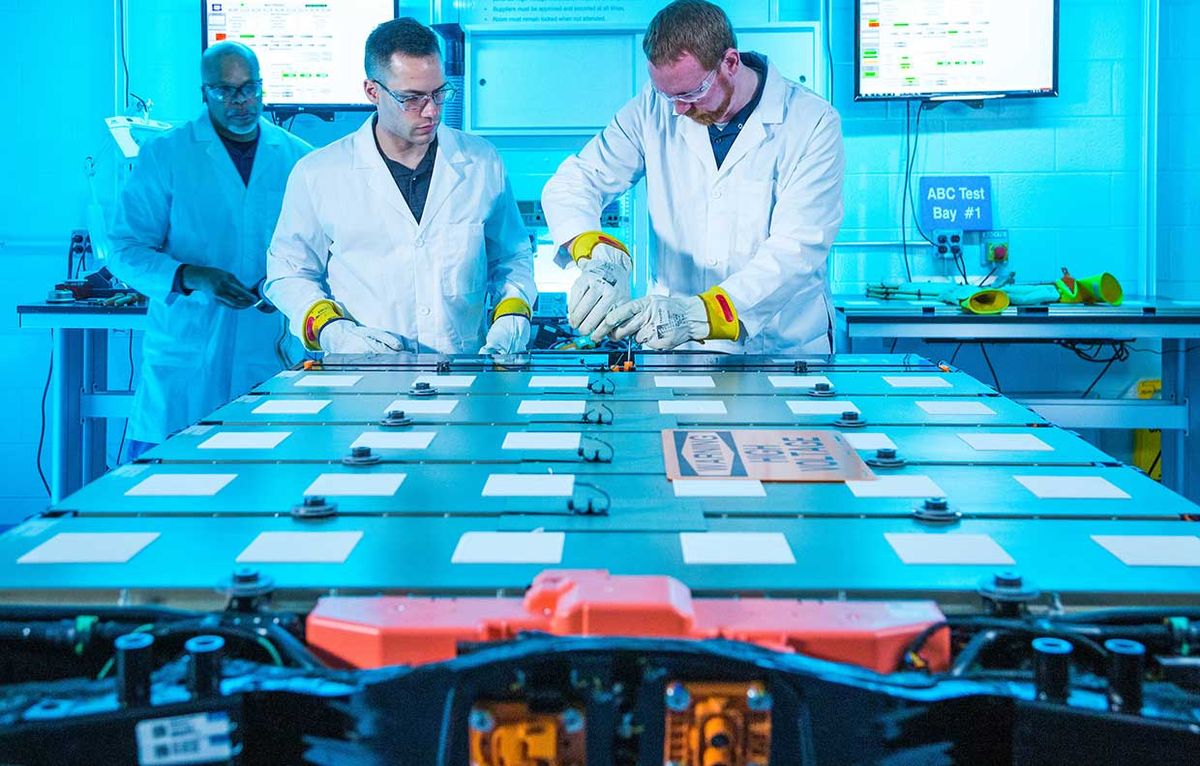When the battery dies in your smartphone, what do you do? You complain bitterly about its too-short lifespan, even as you shell out big bucks for a new device.
Electric vehicles can’t work that way: Cars need batteries that last as long as the vehicles do. One way of getting to that goal is by keeping close tabs on every battery in every EV, both to extend a battery’s life and to learn how to design longer-lived successors.
IEEE Spectrum got an exclusive look at General Motors’ wireless battery management system. It’s a first in any EV anywhere (not even Tesla has one). The wireless technology, created with Analog Devices, Inc., will be standard on a full range of GM EVs, with the company aiming for at least 1 million global sales by mid-decade.
Those vehicles will be powered by GM’s proprietary Ultium batteries, produced at a new US $2.3 billion plant in Ohio, in partnership with South Korea’s LG Chem.
Unlike today’s battery modules, which link up to an on-board management system through a tangle of orange wiring, GM’s system features RF antennas integrated on circuit boards. The antennas allow the transfer of data via a 2.4-gigahertz wireless protocol similar to Bluetooth but with lower power. Slave modules report back to an onboard master, sending measurements of cell voltages and other data. That onboard master can also talk through the cloud to GM.
The upshot is cradle-to-grave monitoring of battery health and operation, including real-time data from drivers in wildly different climates or usage cases. That all-seeing capability includes vast inventories of batteries—even before workers install them in cars on assembly lines.
“You can have one central warehouse monitoring all these devices,” says Fiona Meyer-Teruel, GM’s lead engineer for battery system electronics.
GM can essentially plug-and-play battery modules for a vast range of EVs, including heavy-duty trucks and sleek performance cars, without having to redesign wiring harnesses or communications systems for each. That can help the company speed models to market and ensure the profitability that has eluded most EV makers. GM engineers and executives said they’ve driven the cost of Ultium batteries, with their nickel-cobalt-manganese-aluminum chemistry, below the $100 per kilowatt-hour mark—long a Holy Grail for battery development. And GM has vowed that it will turn a profit on every Ultium-powered car it makes.
The wireless management system will let those EVs balance the charge within individual battery cell groups for optimal performance. Software and battery nodes can be reprogrammed over-the-air. With that in mind, the system was designed with end-to-end encryption to prevent hacking.
Repurposing partially spent batteries also gets easier because there’s no need to overhaul the management system or fiddle with hard-to-recycle wiring. Wireless packs can go straight into their new roles, typically as load-balancing workhorses for the grid.
“You can easily rescale the batteries for a second life, when they’re down to, say, 70-percent performance,” says Meyer-Teruel.
The enormous GM and LG Chem factory, now under construction, will have the capacity to produce 30 gigawatt-hours of batteries each year, 50 percent more than Tesla’s Gigafactory in Nevada. The plant investment is a fraction of the $20 billion that GM is slated to pour into electric and autonomous cars by 2025, en route to the “all-electric future” touted by CEO Mary Barra.
A reborn, electric GMC Hummer with up to 1,000 horsepower will be the first of about 20 GM Ultium-powered models, mainly for the U.S. and Chinese markets, when it reaches showrooms next year. It will be followed by a Cadillac Lyriq crossover SUV in 2022, and soon thereafter by an electric Chevrolet pickup.
Andy Oury, GM’s lead architect for high-voltage batteries, said those customers will see benefits from the wireless system, without necessarily having to buy a new car.
“Say, seven years from now, a customer needs an Ultium 1.0 battery, but we’re already using 2.0.,” Oury said. “As long as they’re compatible, we can install the better one: Just broadcast the new chemistry, and incorporate new calibration tables to run it.”
Tim Grewe, GM’s director of global electrification, says consumers may soon expect batteries to last four to five times as long as today’s, and companies need to respond. To that end, the wireless system stores metadata from each cell. Real-time battery health checks will refocus the network of modules and sensors when needed, safeguarding battery health over the vehicle’s lifespan. Vehicle owners will be able to opt in or out of more extensive monitoring of driving patterns. Analyzing that granular data, Grewe said, can tease out tiny differences between battery batches, suppliers, or performance in varying regions and climates.
“It’s not that we’re getting bad batteries today, but there’s a lot of small variations,” says Grewe. “Now we can run the data: Was that electrolyte a little different, was the processing of that electrode coating a little different?
“Now, no matter where it is—in the factory, assembling the car, or down the line—we have a record of cloud-based data and machine learning to draw upon.”
The eco-friendly approach eliminates about a kilogram per vehicle, as well as three meters of wiring. Jettisoning nearly 90 percent of pack wiring ekes out another advantage: Throughout the industry, wired battery connectors demand enough physical clearance for human techs to squeeze two fingers inside. Eliminating the wiring and touchpoints carves out room to stuff more batteries into a given space, with a lower-profile design. Which leaves plenty of room for a thumbs-up.
Lawrence Ulrich is an award-winning auto writer and former chief auto critic at The New York Times and The Detroit Free Press.



